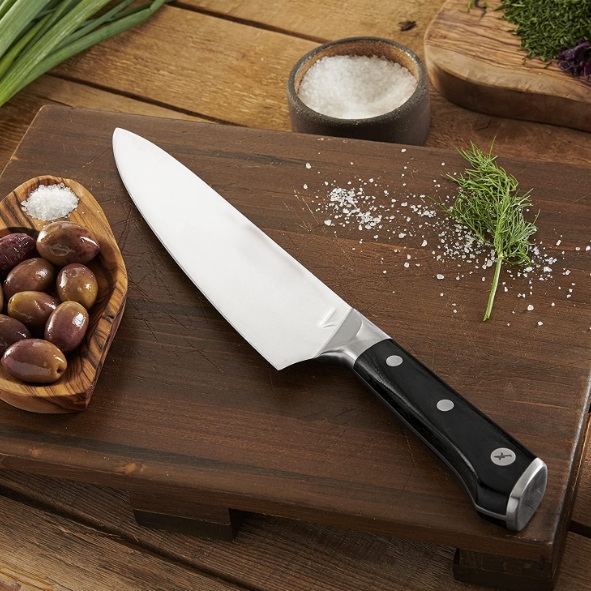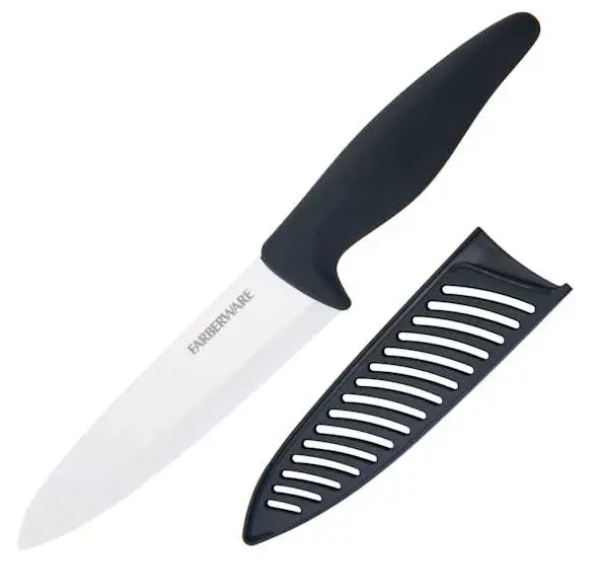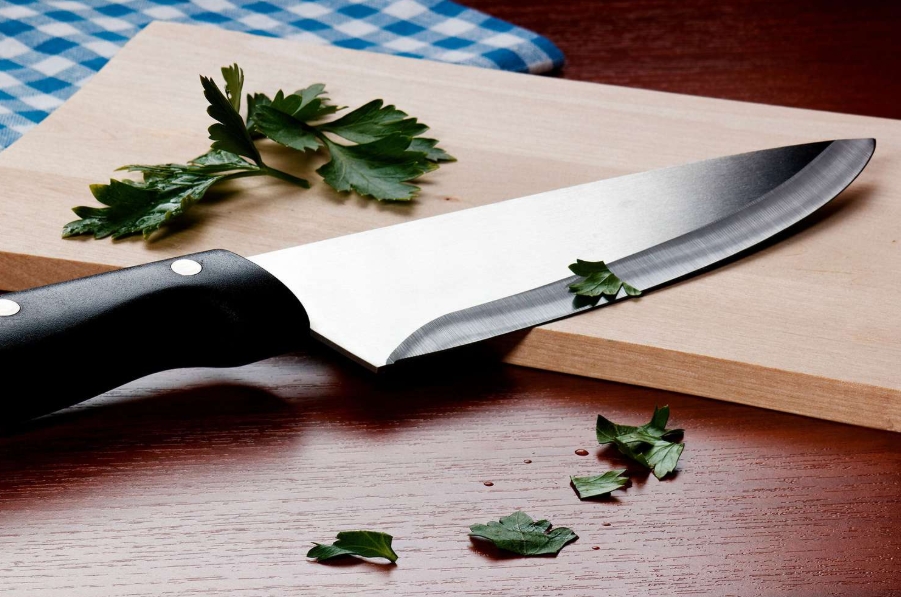

Views: 222 Author: Ella Publish Time: 2025-04-27 Origin: Site








Content Menu
● Introduction to Chef Knives and Gyuto Knives
● Key Differences Between Chef Knives and Gyuto Knives
>> Blade Shape and Cutting Style
>> Blade Material and Edge Retention
● Similarities Between Chef Knives and Gyuto Knives
● Detailed Comparison of Use Cases
>> Videos
● How to Choose Between a Chef Knife and a Gyuto Knife
● Care and Maintenance Tips for Both Knives
● FAQ
>> 1. What is the main difference between a chef knife and a Gyuto knife?
>> 2. Which knife is better for beginners?
>> 3. Can a Gyuto knife replace a chef knife?
>> 4. How do I maintain and sharpen a Gyuto knife?
>> 5. What blade length is ideal for a Gyuto knife?
In the world of culinary tools, the chef knife and the Gyuto knife stand out as two of the most versatile and essential knives in any kitchen. Both are designed to handle a wide variety of tasks, from chopping vegetables to slicing meat, yet they originate from different culinary traditions and feature distinct design elements. This comprehensive article explores the differences and similarities between these two knives, helping you understand which might be the right choice for your cooking style.

The chef knife is a staple in Western kitchens, known for its broad, curved blade that typically ranges from 7 to 10 inches (180mm to 250mm) in length. It is designed to be an all-purpose knife capable of chopping, slicing, dicing, and mincing a wide variety of ingredients. The curved blade facilitates a rocking motion, making it efficient for chopping herbs and vegetables. Its robust build allows it to handle tougher ingredients and heavier tasks, making it a dependable tool for both professional chefs and home cooks.
The Gyuto knife is the Japanese equivalent of the Western chef knife, often called the "beef sword" (with *gyu* meaning cow and *to* meaning blade). It originated as a meat-cutting knife but has evolved into a versatile kitchen tool suitable for slicing meat, fish, vegetables, and herbs. Gyuto knives typically have a thinner, lighter blade with a straighter edge and a sharper, more pointed tip. Blade lengths generally range from 180mm to 270mm, with 210mm being a popular size for home cooks. The Gyuto's design reflects the precision and finesse characteristic of Japanese culinary traditions.
| Feature | Chef Knife | Gyuto Knife |
|---|---|---|
| Origin | Western culinary tradition | Japanese culinary tradition |
| Blade Length | 180mm to 210mm (7-8 inches) | 210mm to 270mm (8-10.5 inches) |
| Blade Shape | Curved blade with a pointed tip | Flatter blade with a sharper, pointed tip |
| Blade Thickness | Thicker and more robust | Thinner and lighter |
| Blade Edge Angle | Around 20 degrees | Around 15 degrees (sharper edge) |
| Blade Hardness | Softer steel, easier to sharpen | Harder steel, holds edge longer but harder to sharpen |
| Cutting Style | Rocking motion | Push-pull slicing and rocking motion |
| Weight | Heavier, more stable | Lighter, more agile |
| Handle | Usually full tang, wooden or composite | Often wooden with hidden tang |
| Tip | More pointed but rounded for control | Sharper and more pointed for precision |
One of the most noticeable differences between the chef knife and the Gyuto knife is the blade shape. The chef knife features a more pronounced curve along the edge, which facilitates a rocking motion when cutting. This motion is particularly useful for chopping herbs, vegetables, and garlic quickly and efficiently. The curved blade allows the tip and heel to stay in contact with the cutting board, providing continuous cutting action.
In contrast, the Gyuto knife has a flatter edge with a less pronounced curve, which makes it better suited for push-pull slicing techniques. This flatter profile allows for more precise, thin cuts, especially when working with delicate ingredients such as fish or thinly sliced meats. The sharper, pointed tip of the Gyuto also enhances its ability to perform intricate tasks like scoring or detailed vegetable work.
Another significant difference lies in the steel used to craft these knives. Gyuto knives are often made from harder, high-carbon steel or premium stainless steel alloys, which allow the blade to maintain a sharper edge for longer periods. This hardness, however, makes the blade more brittle and susceptible to chipping if not handled carefully. Additionally, harder steel requires more skill and the right tools to sharpen effectively.
Chef knives, on the other hand, are usually made from softer steel that is easier to sharpen and more forgiving during use. While they may require more frequent honing and sharpening, this softer steel reduces the risk of chipping and is often preferred by cooks who want a low-maintenance knife.
The handle design of these knives reflects their cultural origins and intended usage. Gyuto knives typically feature traditional Japanese-style handles made from wood, often magnolia or rosewood, with a hidden tang construction. These handles tend to be lighter and more slender, providing a different grip feel that emphasizes control and finesse.
Chef knives usually have heavier, full tang handles made from wood, plastic, or composite materials. The full tang construction provides balance and durability, making the knife feel more substantial in hand. The ergonomics of chef knife handles are designed to accommodate a firm grip, suitable for heavy chopping and prolonged use.
Despite their differences, these knives share many characteristics:
- Both are multi-purpose, versatile knives suitable for a wide range of kitchen tasks including chopping, slicing, dicing, and mincing.
- Both have relatively long blades, averaging about 8 inches in length, suitable for handling large ingredients.
- Both blades have a curved edge, facilitating a rocking motion for efficient cutting, though the degree of curvature varies.
- Both are designed with double bevel edges in most modern versions, allowing for ambidextrous use.
- Both knives require proper maintenance and sharpening to keep their edges in optimal condition.
- Both are favored by professional chefs and serious home cooks for their versatility and performance.

Chef knives excel in tasks requiring a rocking motion, such as chopping herbs, vegetables, and crushing garlic. Their robust build allows them to handle heavier tasks like cutting through tougher vegetables or light disjointing of meat. The broader blade also makes them suitable for scooping chopped ingredients from the cutting board to the pan, adding to their practicality in a busy kitchen.
The chef knife's weight and sturdiness make it ideal for tasks that require more force, such as cutting through root vegetables like carrots or potatoes. The curved blade edge also helps maintain a smooth, continuous cutting motion, reducing fatigue during prolonged use.
Gyuto knives are favored for precision slicing and delicate work, such as filleting fish or slicing thin cuts of meat. Their lighter weight and sharper edge make them ideal for push-pull slicing techniques and fine dicing. The thinner blade allows for cleaner cuts with less resistance, preserving the texture and flavor of delicate ingredients.
Additionally, the Gyuto's design is well-suited for the preparation of Japanese cuisine, where precision and presentation are paramount. Its sharper tip and thinner blade make it easier to perform detailed tasks such as scoring vegetables or trimming fat from fish.
- Knife Skills Tutorial by Epicurious: Learn essential knife skills including chopping, dicing, and slicing techniques applicable to both knives.
- Gyuto Vs. Western Chef's Knives : A quick visual comparison of Gyuto and Western chef knives highlighting weight, blade design, and cutting style differences.
Choosing between a chef knife and a Gyuto knife depends on several factors, including your cooking style, maintenance preferences, and the types of dishes you prepare.
- Cutting Style Preference: If you prefer a rocking chopping motion, a chef knife may be better suited to your needs. If you favor precise slicing and push-pull techniques, the Gyuto excels.
- Weight and Control: Choose a Gyuto for a lighter, more agile knife that reduces hand fatigue during delicate work. Opt for a chef knife if you want more heft and stability for robust tasks.
- Maintenance: Gyutos require more careful sharpening and maintenance due to harder steel. Chef knives are easier to maintain and sharpen, making them ideal for cooks who prefer low-maintenance tools.
- Cuisine Type: For Japanese or precision cooking, a Gyuto is ideal. For Western-style cooking and general use, a chef knife is a classic choice.
- Handle Preference: Consider handle comfort and grip style; Gyutos often have traditional wooden handles, while chef knives have ergonomic full tang handles designed for a secure grip.
- Budget: Generally, Gyuto knives can be more expensive due to the quality of steel and craftsmanship, while chef knives offer a wider range of price points.
Proper care is essential to prolong the life and performance of both chef knives and Gyuto knives.
- Hand Washing: Always wash your knives by hand with mild soap and warm water. Avoid putting them in the dishwasher, as harsh detergents and high heat can damage the blade and handle.
- Dry Immediately: Dry knives immediately after washing to prevent rust and corrosion, especially for high-carbon steel Gyuto knives.
- Sharpening: Use a whetstone or professional sharpening service to maintain the edge. Gyuto knives require a finer sharpening angle (around 15 degrees), while chef knives are typically sharpened at about 20 degrees.
- Honing: Regular honing with a honing rod helps maintain the blade's edge between sharpenings.
- Storage: Store knives in a knife block, magnetic strip, or protective sheath to protect the blade and prevent accidents.
Both the chef knife and the Gyuto knife are indispensable tools in the kitchen, each bringing unique advantages based on their design and cultural origins. The chef knife offers robustness and versatility with its curved blade and heavier feel, perfect for those who favor a rocking chopping technique. The Gyuto knife, with its thinner, lighter blade and sharper edge, provides precision and agility, ideal for slicing and fine work. Understanding the subtle differences in blade shape, steel hardness, cutting style, and handle design can help you select the knife that best suits your culinary needs and preferences. Whether you choose a Gyuto or a chef knife, investing in a quality blade will elevate your cooking experience and make food preparation more enjoyable and efficient.

The main difference lies in the blade design and cutting style: chef knives have a curved blade suited for rocking motions, while Gyuto knives have a flatter, thinner blade optimized for push-pull slicing and precision cuts.
Chef knives are generally easier for beginners due to their robust design and easier maintenance. Gyutos require more care in sharpening and handling but offer superior precision once mastered.
Yes, a Gyuto knife can replace a chef knife as it is a versatile all-purpose knife suitable for most kitchen tasks, especially if you prefer lighter, sharper blades.
Gyuto knives should be sharpened using a whetstone to maintain their sharp edge and avoid damage. Regular honing and careful hand washing are recommended to preserve the blade.
Blade lengths between 210mm and 240mm are popular for home cooks, balancing control and cutting capacity. Longer blades up to 270mm are preferred by professionals for larger tasks.
[1] https://www.koiknives.com/blogs/japanese-knives/gyuto-vs-chef-knife-which-one-is-the-right-option-for-you
[2] https://www.thebambooguy.com/blogs/kitchen-knives/this-vs-that-chef-knife-vs-gyuto-knife
[3] https://cutscrafts.com/what-are-gyuto-knives-used-for/
[4] https://www.istockphoto.com/photos/chef-knife
[5] https://japaneseknifecompany.com/product-category/knives/knife-shapes/gyuto/
[6] https://www.youtube.com/watch?v=YrHpeEwk_-U
[7] https://www.youtube.com/watch?v=1L5PdZOdlUc
[8] https://ubaahaus.co.uk/blogs/blog-archive/gyuto-knife-vs-chef-knife
[9] https://japaneseknivesguide.com/gyuto-chefs-knife/
[10] https://yakushiknives.com/blogs/yakushi-blog-all-thing-knives/finding-the-perfect-gyuto-knife-what-to-look-for
[11] https://www.gettyimages.co.uk/photos/kitchen-knife
[12] https://dalstrong.com/blogs/news/what-is-a-gyuto-knife
[13] https://www.istockphoto.com/illustrations/chef-knife
[14] https://www.freepik.com/free-photos-vectors/chef-knife
[15] https://www.echefknife.com/blogs/blog/complete-guide-to-gyuto-chef-knives-everything-you-need-to-know
[16] https://www.reddit.com/r/Cooking/comments/716cad/any_reason_to_get_a_gyutou_over_a_western_chefs/
[17] https://www.youtube.com/watch?v=gUFuTWMbHfo
[18] https://oishya.com/japanese-knives/chefs-knives-japanese-knives/
[19] https://www.kenonionknives.com/gyuto-vs-chef-knife/
[20] https://www.silverback-knives.com/en/pages/santoku-vs-gyuto-was-ist-der-unterschied
[21] https://www.seriouseats.com/western-versus-japanese-style-chefs-knives-6751328
[22] https://thetenreview.com/gyuto-vs-chef-knife/
[23] https://sharpedgeshop.com/blogs/knives-101/types-of-japanese-kitchen-knives
[24] https://sakutoknives.co.uk/blogs/blog/why-every-kitchen-needs-a-gyuto-knife-discover-the-difference
[25] https://www.blackdragonforge.com/blogs/knifemaking/gyuto-vs-chefs-knife-choosing-the-right-blade-for-your-kitchen
[26] https://hasuseizo.com/blogs/japanese-kitchen-knives/what-are-gyuto-knives-used-for
[27] https://oishya.com/web-stories/chefs-daily-knives-santoku-vs-gyuto/
[28] https://www.procook.co.uk/shop/knives-scissors/chefs-knives
[29] https://unsplash.com/s/photos/chef-knife
[30] https://yuzuknives.co.uk/products/gyuto-chef-knife
[31] https://www.youtube.com/watch?v=QgVyN6Lpiuc
[32] https://www.youtube.com/watch?v=lN3zMWDRsKw
[33] https://stock.adobe.com/search?k=chef+knife
[34] https://jikkocutlery.com/collections/gyuto-chef-knife
[35] https://www.youtube.com/watch?v=-al-bs737fw
[36] https://www.youtube.com/watch?v=idSstlMJuLE
[37] https://www.youtube.com/watch?v=4-U5D2SyCOY
[38] https://www.shutterstock.com/search/chefs-knife
[39] https://oishya.com/journal/guide-to-buying-your-first-japanese-knife/
[40] https://www.koiknives.com/blogs/japanese-knives/frequently-asked-questions-about-k-tip-gyuto-knife
[41] /what-s-the-best-japanese-chef-knife-right-now.html
[42] https://hasuseizo.com/pages/knife-types
[43] https://elementknife.com/pages/common-questions-about-kitchen-knives
[44] https://www.chefknivestogoforum.com/chef-s-knife-vs-gyuto-t2949.html
[45] https://www.reddit.com/r/chefknives/comments/jerlop/questions_about_my_first_good_set_of_knives/
[46] https://www.chefs-edge.co.uk/blogs/knife-information/the-ultimate-guide-to-japanese-chef-knives-2024
[47] https://cuttingedgeknives.co.uk/pages/how-to-choose-the-right-japanese-knife
[48] https://www.chefsteps.com/forum/posts/questions-about-knives
[49] https://www.kitchentime.com/inspiration/guides/japanese-knife-guide/